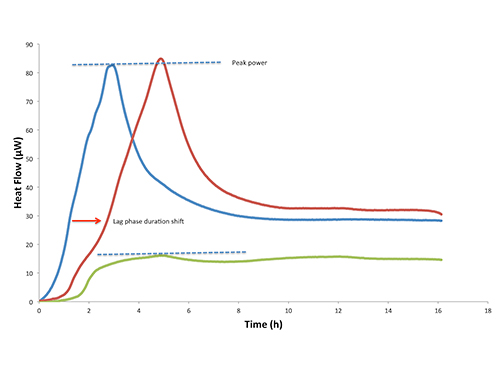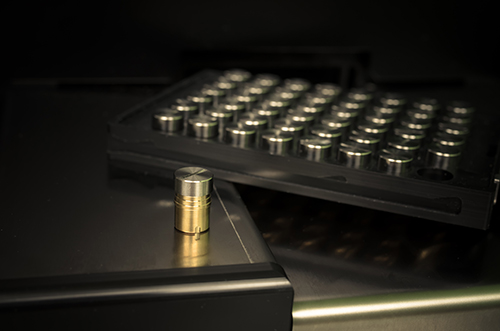Magnus Jansson Ph.D. CSO SymCel Sverige
New Tools for Better Antimicrobial Drug Development
The problem of multi-resistant bacteria is increasing, and the health-care costs and implications are a global concern. Consequently, the search is on for novel solutions.
The use of a sensitive label-free cell-based assay that can measure bacterial activity in real-time in complex setups with minimal effort is needed: enter calorimetry. The properties of calorimetry-based cell monitoring, and the data produced, are uniquely well suited to the development of novel antibiotics.
Calorimetry measures the power produced in a cell culture at any given time as Joules/second (W). The heat produced is a measurement of the metabolic processes in the cells and gives a true phenotype fingerprint of the organism measured. Different bacteria and different treatments give rise to unique heat profiles revealing significant information about the system tested. Calorimetry has the advantage of being a label-free and non-destructive measurement, making post-experimental analysis possible while being totally independent of morphology of the sample. Consequently, assays can be performed on bacteria in solution as well as on solid media, including three-dimensional matrixes like bone biopsies, surgical and dental implant materials, while being totally indifferent to turbid or fluorescent properties of the system.

Heat flow curves of serial dilutions of S. typhimurium demonstrating the shift in lag time and consistent maximal heat output. Curve shape is specificfor the combination of strain and media used.
One of the unique properties of calorimetry-based metabolic monitoring of bacterial growth is that the pattern of energy expenditure is species, as well as strain specific; each bacteria giving rise to a specific growth pattern as heat production over time. The metabolic output assay thus becomes both quantitative as well as qualitative. Even minor changes in growth behavior such as metabolic pathway mutations are detected as well as biofilm formation and most importantly antimicrobial sensitivity.
By integrating the metabolic power over time to accumulate heat over time (in Joules) a growth curve is established equivalent to a traditional growth curve (as measured by optical density of the culture). From this data, it is possible to calculate both the lag-time and the maximal growth rate of the culture. This is the basis for determining the effect of antibiotic treatment.
Bioavailability of a novel compound is an important factor. Since the calorimetric measurement is a measurement of the total metabolism, bioavailability is a non-issue since that is accounted for in the measurement.

Integration over time for the data from Figure 1. A growth curve can be derived by plotting the accumulated energy release. Fitting the data to growth models allows the determination of lag-phase time and maximum growth rate. The maximum growth rate corresponds to the maximum slope of the heat over time curve. Duration of the lag phase is measured as the time from the start of the experiment to the interception of a line tangent to the maximum growth rate point and the baseline.
Calorimetric monitoring is completely independent of the sample morphology. Colonization in complex matrices, e.g., bone, is notoriously hard to assay. Normal assays cannot give a representative sample of bacteria colonizing three-dimensional surfaces. Consequently, microscopy, fluorescence, and molecular methods are prone to large deviations. The heat produced by bacterial metabolism in 3D matrix settings is readily measured regardless of the sample properties, giving access to whole new areas of investigation.
The bacterial growth assay in calorimetry can be performed in both liquid and solid media—allowing the investigation of different properties during colonization of, for example, dental and surgical implant materials.
One of the standard dilemmas of antibiotic development is the correct quantification of the number of cells, not to mention the number of living cells. Since many bacteria give rise to clustered cells, biofilms etc., there is likely to be a misrepresentation by using standard plating/growth analysis. What is counted for as a single colony may originate from a cluster of living bacteria; thus giving false numbers for efficacy. Calorimeter-based assays only account for the actual number of metabolic active, live cells. This has implications for the comparison to DNA- or protein- based assays where it can be difficult to distinguish between the number of live active cells and DNA/protein remaining in inactive/dead cells protected by biofilm.

Heat flow curves of E. coli growth without antibiotic and two different concentrations of antibacterial compound. The inoculum of bacteria is identical for all three samples. The blue curve depicts untreated sample; red represents the low concentration of antibiotics demonstrating a prolonged lag phase but similar maximum peak power. The green curve depicts a high antibiotic concentration demonstrating a shift in lag-phase time as well as growth rate and peak output power. All samples show that there is residual metabolic activity, even for prolonged experiments, the cells still metabolize to some extent.
It is easy to monitor the metabolic activity for prolonged times using calorimetry, the typical assay can run from a couple of hours up to days or weeks if needed: all with continuous monitoring. This allows the monitoring of persister-cells or cells derived with antibiotic resistance by natural selection pressure. Persister cells will give rise to metabolic activity at a lower but constant rate during a prolonged time and can be distinguished in the assay. Development in more native conditions such as a serum supplemented growth media, mimicking the conditions in the human body, is also a proposition for the calorimetric assay. The possible degradation and instability of tested compounds gives rise to the re-growth of persister cells, all easily monitored by following the total metabolic state of the culture for prolonged times.
There is a growing interest in the use of potentiating treatments to increase the efficacy of antibiotics. Multiple modes of action of combined therapies, as well as the use of potentiating compounds, with no inherent antibiotic properties are easily monitored using the calorimetric assay. The cooperative effects of two or more compounds are readily followed and since there is no need to know the mechanism of action prior to the experiment, there is an unbiased phenotype screening only. Calorimetry is also a very “open” type of cell-based assay that is not limited to a specific cell type or setting. It is a valid proposal to test the toxicity of novel chemical entities on mammalian cell systems using the same equipment used for testing the antibacterial potency, this makes the system a good value proposal.

Integration over time for the data from Figure 3. The growth curves demonstrate that the low antibiotic concentration has a shift in lag-phase time but similar maximum growth rate indicative of a bactericidal action (red curve). The green curve, high initial concentration, shows a prolonged lag phase as well as a significantly decreased growth rate, indicative of additional bacteriostatic effect at high concentration.
Magnus Jansson, Ph.D. ([email protected]), is CSO at SymCel Sverige.



